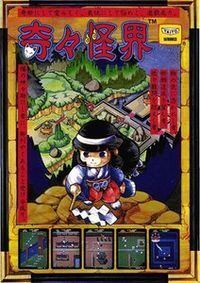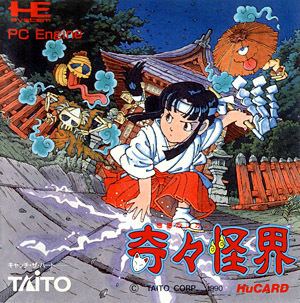9.4 /10 1 Votes
Composer(s) Hisayoshi Ogura Initial release date 18 September 1986 Genre Shoot 'em up Mode Single-player video game | 4.7/5 Emuparadise Cabinet Upright Developer Taito Publisher Taito | |||||||||||||||||||||||||||||||||
 | ||||||||||||||||||||||||||||||||||
Designer(s) Mikio Hatano (director)
Toshiyuki Nishimura (character)
Kazuya Mikata (character) Display Raster, standard resolution
vertical orientation Platforms Arcade game, TurboGrafx-16, Mobile phone, Family Computer Disk System, MSX, Microsoft Windows, Java Similar Taito games, Shoot 'em up games | ||||||||||||||||||||||||||||||||||
Arcade longplay 216 kiki kaikai
KiKi KaiKai (奇々怪界, lit. "Mysterious Ghost World") is a shoot 'em up developed and published by Taito Corporation originally for Japanese arcades in 1986. Since then, the game has received a number of console and home computer ports in and outside Japan, both as a stand-alone title and as part of compilations. The game originally saw a limited release in North American and European arcades as Knight Boy, a bootleg copy of the original Japanese version not officially licensed by Taito.
Contents
- Arcade longplay 216 kiki kaikai
- Let s play kiki kaikai pocky rocky let s play arcade classic arcade game reviews
- Plot and setting
- Gameplay
- Development
- Ports
- Music
- Reception
- Legacy
- References

Set in Feudal Japan, the player must assume the role of a Shinto shrine maiden named "Sayo-chan" who must use her o-fuda scrolls and ohari Gohei wand to defeat a number of renegade spirits and monsters from Japanese mythology. The game is noteworthy for using a traditional fantasy setting in a genre otherwise filled with science fiction motifs.

Let s play kiki kaikai pocky rocky let s play arcade classic arcade game reviews
Plot and setting

The game follows the adventures of "Sayo-chan", a young Shinto shrine maiden living in Feudal Japan. One night, while Sayo-chan is fanning a ceremonial fire, she is visited by the Seven Lucky Gods, who warn her of a great, impending danger. Suddenly, a band of mischievous goblins appear and kidnap the gods, quickly retreating to a faraway mountain range. Sayo-chan, determined to help the gods, sets off on a journey across the countryside, where she confronts a number of strange creatures from Japanese mythology, including yokai, obake, and yurei-like monsters. After defeating several powerful goblin leaders, Sayo must battle their leader, the ancient serpent Orochi.
Gameplay

KiKi KaiKai is an overhead multi-directional shooter game that requires the player to move in four directions through various levels while attacking harmful enemies as they approach from off screen. As Sayo-chan, the player can attack by either throwing her special o-fuda scrolls in eight separate directions, or by swinging her purification rod directly in front of her. These techniques can be upgraded by finding special paper slips left by defeated enemies that will either enhance their power or improve their range. Sayo can be damaged by coming in contact with an enemy, and can only be hit once before she is knocked out and must resume the level from a preset continuation point. At the end of each level, the player must face a powerful boss monster that takes several attacks to defeat and is more difficult than normal enemies.

Several hidden items can be found by attacking objects with Sayo's purification rod, and can be used to either enhance her attack or grant the player points. Once a certain number of points are gained, the player will gain another life and have an additional chance to complete a level. When all of the player's lives are exhausted, a "number match" screen appears with a random 3-digit number in 50-base increments (100, 150, 200, 250, and so on). If the last three digits of the player's total score match the number displayed, they are granted a free game; if not, the game ends.

The Family Computer Disk System version of KiKi KaiKai introduced a few gameplay changes over the original arcade version, including new levels and enemies, as well as limiting the number of times the player may use Sayo-chan's ranged o-fuda attack, along with a second playable character: "Miki-chan", another shrine maiden who is designated as the player two character. Though several additional ports would be made over the years, each one would rely on the same basic game mechanics.
Development

KiKi KaiKai was originally created in 1986 by Taito game designer Hisaya Yabusaki. Pulling inspiration from tales of Japanese mythology, as well as several top-down arcade shooters popular during the era, the game put a conventional spin on the usually technologically driven science-fiction "Shoot 'em up" titles at the time. Utilizing action game elements, the player is free to move about the screen as they choose, instead of being forced forward in normal scrolling shooter fashion. While similar to the earlier released game Commando in both style and presentation, Kiki KaiKai is described by Taito as a "lovely action game" offering an "exotic Asian atmosphere".
Shortly after the game's Japanese debut, a bootleg version called Knight Boy was released for arcades in various countries. This version, though not officially licensed by Taito, was an exact duplicate of the original KiKi KaiKai with an altered title screen, and contained no new gameplay elements or features.
Ports
KiKi KaiKai has been ported to numerous home consoles and personal computer systems since its original arcade release. The game's first home version was released for the MSX2 on February 10, 1987, with minor gameplay adjustments. On August 28, 1987, a version for the Disk System was released entitled KiKi KaiKai: Dotouhen, which added two-player support and a new playable character, "Miki-chan". A PC Engine version was released three years later on March 27, 1990, which was largely based on the previous Disk System instalment. The game made the jump from consoles on June 12, 2003, when Taito developed a java-based version of KiKi KaiKai for mobile phones called KiKi KaiKai: The Bizarre World. A port programmed by MediaKite appeared on May 14, 2004 for Windows-based PCs, and a web-based game service was launched on Taito's Japanese website later that year courtesy of EZWeb.
KiKi KaiKai was also made available along with various other classic Taito titles in a number of compilations. It would appear in the Japanese-only Taito Memories Vol. 1 for the PlayStation 2 on July 28, 2005, and again in Taito Pocket Memories for the PlayStation Portable in 2006. The game would be officially released in English for the first time as part of Taito Legends 2 for the PlayStation 2, PC, and Xbox released in North America in May 2007, and later in Taito Legends: Power-Up for the PlayStation Portable.
Music
KiKi KaiKai's soundtrack, composed by Hisayoshi Ogura, is reflective of traditional Japanese folk music, mostly utilizing woodwind and string instruments like the shamisen with an electronic beat. The music was originally presented in mono format, and was composed entirely of synth-based chiptunes, a standard audio development system for older video game hardware. An exclusive game soundtrack was never released commercially, but all the music from the game was featured on the 1987 album Taito Game Music (catalog number 28XA-110) published by Alfa Music as a single track medley. Each song was later presented as individualized tracks on the 2002 re-release of Taito Game Music (SCDC-00156), this time published by Sci-Tron Digital Content.
Reception
Despite frequent ports, KiKi KaiKai has garnered harsh reviews long after its initial release. GameSpot considers the games one of Taito's sleepier titles, and of overall less quality than their other classic games like Bubble Bobble and Double Dragon (the latter was licensed from Technos for the U.S.). The game's graphics, though unique at the time they were produced, did not preserve well, with AllGames.com remarking that "once you get over your initial amusement at the game's smiling ghosts and comical skeletons, you'll find the graphics to be dull. The controls were seen as simplistic, yet responsive, though each of the game's levels were found to be too monotonous.
Legacy
Like The Ninja Warriors, KiKi KaiKai had been a one-off work until 1992, when Taito allowed Natsume to release KiKi KaiKai: Nazo no Kuro Mantle, which would be known as Pocky & Rocky for its North American release. Natsume would follow up with Pocky & Rocky 2, and years later would help Altron to release Pocky & Rocky with Becky.
A modern continuation to KiKi KaiKai, KiKi KaiKai 2, was originally in development for the PlayStation 2 console by Starfish Entertainment and set for a 2006 release, but was canceled early in its development only to reemerge as the unlicensed spiritual successor with title Kiki Kai World, which later became Heavenly Guardian when published.
The protagonist of the game's design, as well as the ghost enemies, would later become heavy influences for the characters Reimu Hakurei and equivalent ghost enemies respectively in the Touhou Project games on the PC-98.
In WarioWare D.I.Y., Sayo-chan from KiKi KaiKai was appeared as the microgame.
